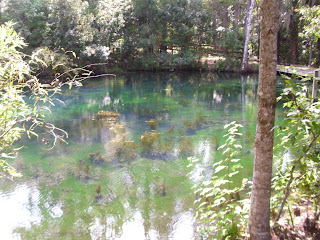On Sunday, September 19, we decided to visit a couple of local state parks. Chris was otherwise engaged and unable to join us, so we opted for parks he had already visited. I realize we could have gone anywhere we wanted, but Chris has been to so many places with us, it seems only right to wait for him to go to new parks. And so, we chose to visit Bulow Creek State Park and Bulow Plantation Ruins Historic State Park in Ormond Beach.
Bulow Creek is a small park, but it's home to many things. There is a small trail, the Wahlin Trail, dedicated to a man who was dedicated to the park. There is also a larger trail, the Fairchild Oak Hiking Trail, which connects Bulow Creek State Park to the Bulow Plantation Ruins Historic State Park, six miles away. There are the remains of a land sales office:
There is also the Fairchild Oak, a massive live oak older than Jesus and nearly as big:
Then there's that other thing Bulow Creek has. That little thing we thought we were prepared for but were woefully wrong....
Mosquitoes.
I would show you pictures from our short walk down the Wahlin Trail, but they aren't any good. They're all blurry, because if we stood still to pose we got swarmed. And we weren't standing still, either. We were waving our arms around like idiots to keep the little suckers from landing. (And from Rob: It wasn't so much a nature trail as it was a mosquito dash!)
So, we took a few shots of the Fairchild Oak and the things around the parking area for posterity, and then we hightailed it outta there. We hate to up and leave like that, but it was unbearable.
Thankfully, Bulow Plantation Ruins was another story altogether. The park was once a sprawling estate and sugar mill owned by Major Charles Wilhelm Bulow, farmed by slaves, and burned down by Seminole Indians. Foundation stones from the slave quarters and the estate house are left, along with the massive ruins of the sugar mill. This is all situated on the banks of the Bulow Creek, and we had a really nice time strolling the grounds.
Our first stop was the dock, where three generations of one family were out fishing (grandma, mom, and daughter were on the dock while dad was in a little johnboat next to it...which I thought was pretty funny.). Looking out onto the water, it's easy to see why Bulow Creek is one of Florida's State Canoe Trails:
I love my kid. I really, truly, do.
So, after leaving the dock we hit the nature trail to the sugar mill itself. Along the way we passed the foundation to some of the slave quarters. I can't even begin to imagine what life here was like for them. I wonder how things would be today if slavery hadn't existed as it had. I'm not going to go deep with this subject, but seeing evidence of it puts things in a new light.
The walk through the woods was beautiful. No mosquitoes, thankfully, and the weather wasn't too hot either. A few highlights:
This tree was used for turpentine. You can tell by the slash marks in the bark.
Pretty soon we came to a break in the trees and the ruins loomed before us. Rob and I both had the same thought....Indiana Jones!
I never realized how many sugar mills once existed in the state of Florida. We've been to 4 or 5 ruins in the past six months, and this is probably one of the better preserved ones. We wandered around for awhile, only seeing one or two other couples the entire time. Here are a few pictures:
Our exploration led us around the ruins, back to the spring house, and then on to the interpretive center. It was neat seeing the different artifacts that have been recovered from the property. They sure did drink a lot of rum!
And afterwards, we enjoyed a nice picnic by the water. The breeze cooled us, the serenity calmed us, and the history reminded us of where we've come from. I call that a successful day.



















































